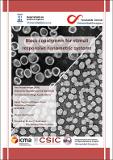Por favor, use este identificador para citar o enlazar a este item:
http://hdl.handle.net/10261/149642COMPARTIR / EXPORTAR:
 SHARE
BASE SHARE
BASE
|
|
| Visualizar otros formatos: MARC | Dublin Core | RDF | ORE | MODS | METS | DIDL | DATACITE | |

| Título: | Block copolymers for stimuli responsive nanometric systems |
Autor: | Abad Andrés, Miriam | Director: | Oriol, Luis CSIC ORCID; Piñol, Milagros CSIC ORCID | Fecha de publicación: | 2016 | Editor: | CSIC-UZA - Instituto de Ciencia de Materiales de Aragón (ICMA) | Resumen: | Amphiphilic block copolymers are able to self-assemble and form polymeric micelles able to encapsulate hydrophobic molecules, or vesicles able to encapsulate both hydrophobic and hydrophilic molecules. By using stimuli responsive polymers, the encapsulated molecules can be controlled release. Light is one of the most investigated stimuli because it can be remotely and locally applied. Photoresponsive polymers are composed by moieties that react or isomerize when they are irradiated with light of a particular wavelength. Azobenzene is one of these functional molecules whose light activity is due to its reversible photoisomerization trans-cis-trans. Azobenzene can be covalently bound to polymeric chains, which is the most frequent situation, or can be bound using the principles of Supramolecular Chemistry, which constitutes a far less explored approach. The aims of this project were: The synthesis and characterization of amphiphilic supramolecular block copolymers containing units of 2.6-diacylaminopiridine (DAP, analog to adenine) capable of binding, via hydrogen bonds, azobenzenes having thymine terminal groups, including the - study of association constants in supramolecular amphiphilic block copolymers. - study of aggregation of amphiphilic supramolecular block copolymers in aqueous solutions by microfluidics to check a fast and reproducible methodology of preparing polymeric nanoparticles. According to these objectives, amphiphilic block copolymers containing DAP units and poly (ethylene glycol) were first synthesized by controlled RAFT polymerization. Azobenzenes having thymine terminal groups are linked through a triple hydrogen bond to the DAP units to give amphiphilic supramolecular block copolymers. All copolymers were characterized by spectroscopic techniques. Association constant (Ka) for H-bond complex was calculated by 1H-NMR titrations. It has a lower value (4 M-1 ) in THF than in chloroform (42 M-1 ) thus H-bonds are weakened due to a solvation effect. Reproducible polymeric aggregates from both block copolymers and supramolecular block copolymers were obtained by microfluidics in THF/water systems. In chloroform/water systems no reproducible results were obtained, so further studies are required. | Descripción: | Final Master Project: Master in Nanostructured Materials for Nanotechnology Applications. Liquid Crystal and Polymer Group of University of Zaragoza. | URI: | http://hdl.handle.net/10261/149642 |
| Aparece en las colecciones: | (ICMA) Tesis |
Ficheros en este ítem:
| Fichero | Descripción | Tamaño | Formato | |
|---|---|---|---|---|
| blocopolymer.pdf | 2,29 MB | Adobe PDF |  Visualizar/Abrir | |
| copolymerANE.pdf | 2,28 MB | Adobe PDF |  Visualizar/Abrir |
CORE Recommender
Page view(s)
206
checked on 19-abr-2024
Download(s)
254
checked on 19-abr-2024
Google ScholarTM
Check
Este item está licenciado bajo una Licencia Creative Commons

